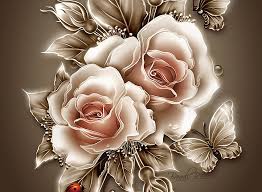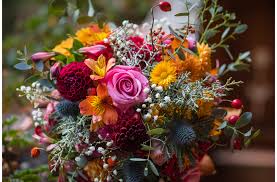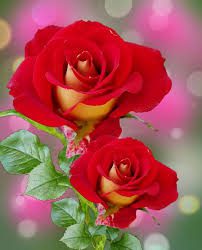Beautiful flowers have the power to captivate our hearts and stimulate our senses with their exquisite colors, enchanting fragrances, and delicate textures. They are nature’s masterpieces, effortlessly showcasing the wonders of life and reminding us of the inherent beauty that exists all around us.
Whether they bloom in vast gardens, wild meadows, or carefully tended pots on windowsills, flowers bring joy, serenity, and a touch of magic to our lives.
The diversity of beautiful flowers is astounding, with countless varieties that differ in shape, size, and hue. From the vibrant petals of the rose to the delicate blossoms of the cherry blossom tree, each flower possesses a unique charm that makes it special.
Some flowers, like the elegant orchids, boast intricate patterns and exotic shapes that never fail to leave us in awe. Others, such as the cheerful sunflowers, radiate warmth and happiness wherever they are found.
One cannot discuss beautiful flowers without mentioning the language of flowers, a form of communication rooted in symbolism. For centuries, cultures across the globe have attributed meanings to different blooms, enabling us to convey emotions and sentiments through the gift of flowers.
A red rose, for instance, symbolizes passionate love, while a daisy represents innocence and purity. The art of selecting the perfect bouquet to express our feelings adds an extra layer of depth to the enchantment of these floral wonders.
Beyond their aesthetic appeal, beautiful flowers play a crucial role in our ecosystems. They entice bees, butterflies, and hummingbirds with their nectar and vibrant hues, facilitating the process of pollination. As pollinators move from one bloom to another, they aid in the reproduction of plants and contribute to the cycle of life. Without the existence of these delicate blossoms, the world would lose not only its visual splendor but also a vital component of its ecological balance.
Furthermore, flowers hold a special place in cultural and religious practices. They are featured in celebrations, ceremonies, and rituals worldwide, symbolizing new beginnings, purity, and the cycle of life and death. In many traditions, garlands of flowers are worn or offered as a sign of reverence and devotion. The presence of flowers in these contexts fosters a sense of connection to nature and spirituality, reminding us of the profound interplay between humans and the natural world.
In our increasingly fast-paced and technology-driven lives, taking a moment to appreciate the beauty of flowers can have a profound impact on our well-being. Studies have shown that being in the presence of flowers can reduce stress, uplift moods, and enhance overall mental health.
Their colors and fragrances have a soothing effect, inviting us to slow down and reconnect with the present moment. Whether it’s a solitary walk in a garden or the simple act of tending to a potted plant, the therapeutic power of beautiful flowers is undeniable.
In addition, beautiful flowers hold an irreplaceable position in the tapestry of our lives. Their exquisite features, symbolic meanings, ecological significance, and therapeutic effects make them a source of wonder and inspiration. Let us cherish these delicate masterpieces of nature and allow their enchanting presence to bring joy, serenity, and a renewed appreciation for the natural world into our lives.
Read Also: 15 Healing Powers of Scent Leaf (Ocimmum gratissimum)
History and Significance of Beautiful Flowers

Throughout history, beautiful flowers have played a significant role in human civilization, leaving an indelible mark on art, culture, and various aspects of daily life. The rich history and profound significance associated with these blooms showcase their enduring influence on humanity.
The cultivation and appreciation of flowers can be traced back thousands of years. Ancient civilizations, such as the Egyptians, Greeks, and Romans, recognized the aesthetic and symbolic value of flowers. They adorned their temples, palaces, and gardens with vibrant blooms, considering them offerings to the gods and embodiments of beauty and fertility.
In the East, the art of flower arrangement known as Ikebana emerged in Japan during the 7th century. Rooted in Buddhist philosophy, Ikebana sought to harmonize nature and human existence through the precise arrangement of flowers, branches, and other natural elements. This practice not only highlighted the beauty of flowers but also encouraged contemplation and mindfulness.
During the Victorian era in the 19th century, flowers gained even more prominence. Victorian society developed an elaborate language of flowers, also known as floriography, which assigned specific meanings to different blooms. Flowers became a means of secret communication, allowing individuals to express emotions and convey messages in a society that discouraged open displays of affection.
Flowers also played a significant role in art, literature, and poetry throughout history. Artists, such as Vincent van Gogh and Claude Monet, immortalized the beauty of flowers on canvas, capturing their delicate forms and vibrant colors. Poets and writers found inspiration in flowers, using them as metaphors for love, beauty, and the fleeting nature of life. From Shakespeare’s sonnets to the haiku of Matsuo Basho, the allure of flowers has been a recurring theme in creative expression.
Beyond their aesthetic appeal, flowers hold deep symbolic meanings in various cultures and religions. In Hinduism, the lotus flower represents purity and spiritual enlightenment, while in Christianity, the lily symbolizes purity and resurrection. Flowers are used in religious rituals and ceremonies worldwide, serving as offerings, decorations, and objects of veneration, fostering a connection between the divine and the earthly.
In modern times, the significance of beautiful flowers has extended beyond their traditional roles. They have become a universal language of love, celebration, and remembrance. From birthdays and weddings to funerals and anniversaries, flowers are a popular choice for expressing joy, sympathy, and commemoration. Bouquets and floral arrangements have become cherished gifts, capable of conveying heartfelt sentiments and bringing comfort during both joyous and difficult times.
Moreover, the cultivation of flowers has become a major industry, with florists, horticulturists, and garden enthusiasts dedicated to growing and preserving the beauty of countless floral varieties. Flower shows and exhibitions around the world showcase the finest blooms, celebrating the artistry and skill involved in nurturing these natural wonders.
However, the history and significance of beautiful flowers span across centuries and cultures. From ancient civilizations to modern society, flowers have enchanted us with their beauty, served as symbols of emotion and spirituality, and provided solace and inspiration. Their timeless allure continues to inspire awe and appreciation, reminding us of the delicate and transformative power of nature in our lives.
Uses of Beautiful Flowers

Beautiful flowers are not only admired for their visual appeal but also find various practical and symbolic uses in our lives. From cultural traditions to therapeutic applications, flowers serve a multitude of purposes that enhance our well-being and add a touch of beauty to our everyday experiences. Here are some notable uses of beautiful flowers:
1. Decoration: One of the most common uses of flowers is for decorative purposes. Whether it’s adorning homes, event venues, or public spaces, flowers bring life and color to any environment. Floral arrangements and bouquets are used to create stunning centerpieces, table settings, and decorative displays for special occasions like weddings, parties, and celebrations.
2. Symbolism and Communication: Flowers have long been associated with symbolism and meaning. They can convey emotions, express sentiments, and communicate messages without words. Different flowers carry distinct symbolism: roses symbolize love and passion, lilies represent purity and rebirth, and sunflowers evoke warmth and happiness. By selecting specific flowers, we can express our feelings and intentions in a thoughtful and symbolic manner.
3. Fragrance and Aromatherapy: Many flowers possess delightful fragrances that can uplift our mood and create a pleasant atmosphere. Essential oils derived from flowers are used in aromatherapy to promote relaxation, reduce stress, and improve overall well-being. Lavender, rose, jasmine, and chamomile are among the popular flowers used in aromatherapy practices.
4. Culinary Uses: Certain flowers are edible and can be used in culinary creations. From adding a touch of elegance to salads and desserts to infusing floral flavors into teas and beverages, flowers like lavender, rose, chamomile, and hibiscus offer unique tastes and aromas. They not only enhance the visual appeal of dishes but also introduce intriguing flavors to culinary experiences.
5. Medicinal and Herbal Remedies: Flowers have been used for medicinal purposes for centuries. Traditional systems of medicine, such as Ayurveda and Traditional Chinese Medicine, utilize flowers in herbal remedies to address various health conditions. Flowers like chamomile, calendula, lavender, and hibiscus are known for their soothing properties, while others, such as echinacea and elderflower, are used for immune support.
6. Cosmetics and Skincare: Many flowers contain beneficial compounds that are utilized in the cosmetics and skincare industry. Floral extracts, essential oils, and floral waters are incorporated into products like perfumes, lotions, creams, and facial masks. Flowers like rose, chamomile, lavender, and jasmine are particularly valued for their skin-nourishing and rejuvenating properties.
7. Pollination and Biodiversity: Flowers play a crucial role in pollination, enabling the reproduction of plants and the production of fruits and seeds. They attract pollinators like bees, butterflies, and birds with their colors and nectar, contributing to the biodiversity and ecological balance of our ecosystems. The presence of flowers in gardens and natural habitats supports the survival of numerous plant and animal species.
8. Therapeutic and Emotional Well-being: The presence of beautiful flowers has a positive impact on our emotional well-being and mental health. Studies have shown that being around flowers can reduce stress, anxiety, and depression while promoting relaxation and a sense of well-being. Engaging in activities like gardening or simply enjoying the sight and fragrance of flowers can provide a therapeutic and mood-lifting experience.
From their aesthetic allure to their practical applications, beautiful flowers enrich our lives in numerous ways. Whether it’s through decoration, symbolism, fragrance, culinary experiences, or therapeutic benefits, flowers continue to be cherished for their versatility, beauty, and ability to evoke positive emotions.
Read Also: Causes of Diseases in Farm Animals and How to Prevent Disease OutBreak
Most Beautiful Flowers

The world is blessed with an incredible array of beautiful flowers, each with its unique charm and appeal. While beauty is subjective and personal preferences vary, here are some flowers that are widely regarded as among the most beautiful:
1. Rose: The rose is often hailed as the epitome of beauty. With its velvety petals, enchanting fragrance, and wide range of colors, roses have captured the hearts of people across cultures for centuries. They symbolize love, passion, and romance, making them a classic favorite.
2. Orchid: Orchids are renowned for their exquisite and exotic beauty. With their intricate and captivating shapes, vibrant colors, and long-lasting blooms, orchids possess an undeniable allure. They symbolize love, luxury, and elegance.
3. Tulip: Tulips are known for their graceful and vibrant blooms. With their sleek petals and diverse range of colors, tulips create stunning displays in gardens and floral arrangements. They symbolize perfect love and are associated with spring and renewal.
4. Lotus: The lotus is a symbol of purity, spirituality, and enlightenment. Its serene and delicate beauty is often associated with tranquility. Rising above muddy waters, the lotus flower’s elegant form and layers of petals evoke a sense of purity and spiritual awakening.
5. Cherry Blossom: Cherry blossoms, or sakura, are renowned for their ephemeral beauty and cultural significance in Japan. These delicate pink or white flowers blanket the trees in a breathtaking display, symbolizing the fleeting nature of life and the arrival of spring.
6. Plumeria: Plumeria, also known as frangipani, is cherished for its fragrant and stunning blossoms. With their waxy petals and vibrant colors, plumeria flowers are synonymous with tropical beauty. They are often used in leis and are associated with love, devotion, and beauty.
7. Lily: Lilies are known for their elegant and dramatic blooms. With their large, showy petals and intoxicating fragrance, lilies command attention and exude grace. They come in various colors and symbolize purity, beauty, and rebirth.
8. Sunflower: Sunflowers embody the warmth and vibrancy of the sun. With their tall stems, large golden-yellow petals, and striking appearance, sunflowers radiate happiness and positivity. They are associated with joy, loyalty, and admiration.
9. Hydrangea: Hydrangeas are renowned for their abundant clusters of flowers and their ability to change color based on soil acidity. Their fluffy, intricate blooms make them a favorite choice for gardens and floral arrangements. They symbolize heartfelt emotions, gratitude, and grace.
10. Peony: Peonies are beloved for their large, lush blooms and captivating fragrance. With their soft and romantic petals, peonies evoke a sense of elegance and beauty. They are associated with prosperity, honor, and romance.
These are just a few examples of the many breathtakingly beautiful flowers found in nature. Whether it’s the classic charm of roses, the exotic allure of orchids, or the delicate grace of cherry blossoms, each flower has its own unique beauty that captivates and enchants admirers around the world.
Read Also: Grocery Gang: Everything You Need to Know
